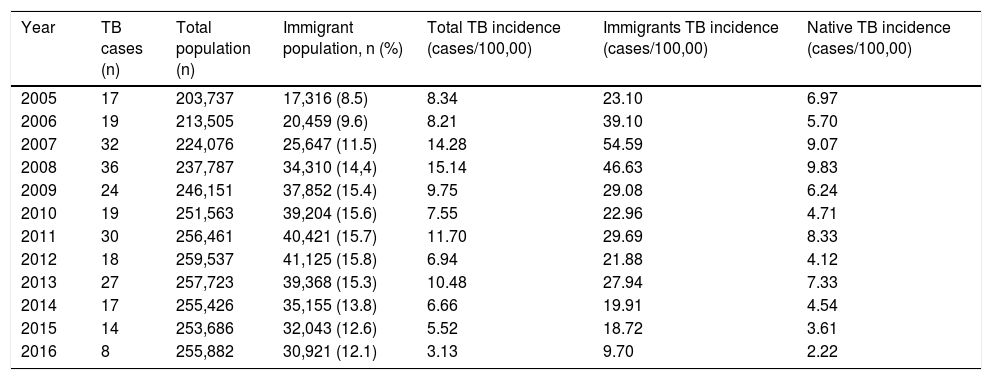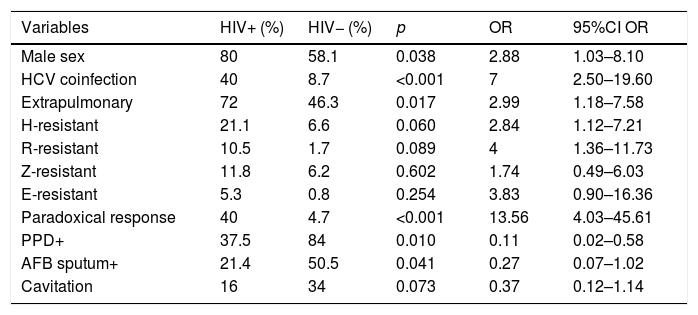Our objective is to analyze the incidence of tuberculosis (TB) in our population and to compare the characteristics of patients with and without HIV infection.
Patients and methodsClinical-epidemiological retrospective cohort study that included patients diagnosed with TB with and without HIV infection between 2005 and 2016 in the province of Guadalajara (Spain). Epidemiological, clinical, microbiological and therapeutic variables were assessed, including microbiological resistances.
ResultsTB was diagnosed in 261 patients. There were 25 patients (9.6%) who had HIV infection. Patients with HIV infection were predominantly males, had higher incidence of hepatitis C virus, a higher percentage of extrapulmonary TB, a higher prevalence of resistance to isoniazid and rifampicin, a greater paradoxical response and a longer average hospital stay. On the other hand, they had a lower percentage of positive tuberculin skin test and positive sputum smear (microscopy). A significant percentage of TB patients had no serology for HIV.
ConclusionPatients with HIV infection show remarkable differences in epidemiological, clinical and resistance variables to antituberculosis drugs. A high percentage of patients with TB were not tested for HIV.
Nuestro objetivo es analizar la incidencia de tuberculosis (TB) en nuestra población y comparar las características de los pacientes con y sin infección por VIH (I-VIH).
Pacientes y métodosEstudio clínico-epidemiológico de cohortes retrospectivo. Se incluyeron pacientes diagnosticados de TB con y sin I-VIH entre los años 2005-2016 en la provincia de Guadalajara (España). Se analizaron variables epidemiológicas, clínicas, microbiológicas y terapéuticas, incluyendo las resistencias microbiológicas.
ResultadosSe realizaron 261 diagnósticos de TB. Hubo 25 pacientes (9,6%) que presentaban I-VIH, los cuales eran predominantemente varones, tenían una mayor incidencia de virus de la hepatitis C, mayor porcentaje de afectación extrapulmonar, una mayor prevalencia de resistencia a la isoniacida y a la rifampicina así como una mayor respuesta paradójica y estancia media más prolongada. Por otra parte, presentaron menor porcentaje de prueba de tuberculina positiva y de baciloscopias en esputo positivas. Un porcentaje significativo de pacientes con TB no tenían realizada una serología para VIH.
ConclusiónLos pacientes con I-VIH muestran notables diferencias en variables epidemiológicas, clínicas y de resistencia a los fármacos antituberculosos. En un porcentaje elevado de pacientes con TB se desconoce su serología para VIH.
Artículo
Comprando el artículo el PDF del mismo podrá ser descargado
Precio 19,34 €
Comprar ahora









